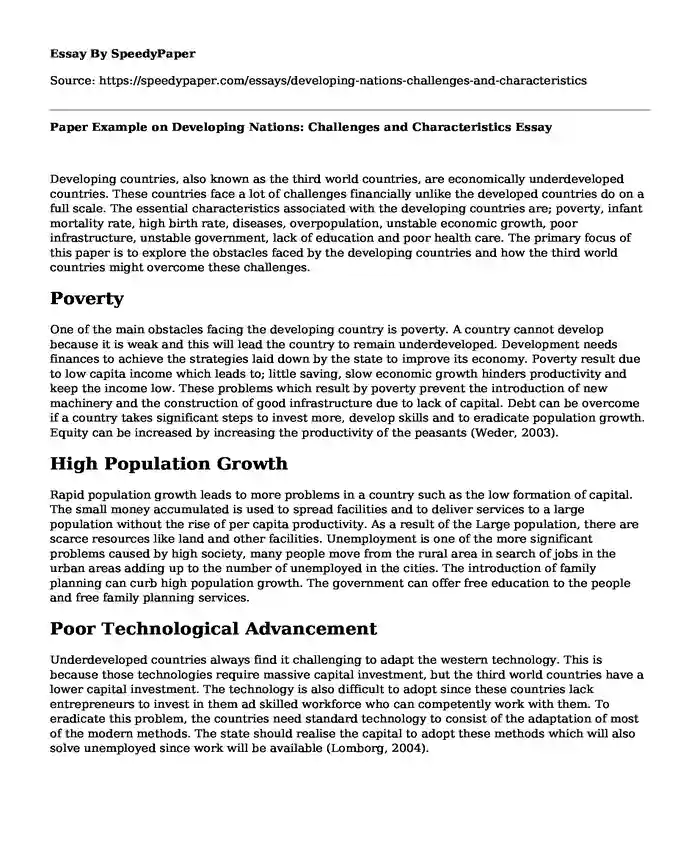
| Type of paper: | Essay |
| Categories: | Economics Government Development |
| Pages: | 3 |
| Wordcount: | 652 words |
Developing countries, also known as the third world countries, are economically underdeveloped countries. These countries face a lot of challenges financially unlike the developed countries do on a full scale. The essential characteristics associated with the developing countries are; poverty, infant mortality rate, high birth rate, diseases, overpopulation, unstable economic growth, poor infrastructure, unstable government, lack of education and poor health care. The primary focus of this paper is to explore the obstacles faced by the developing countries and how the third world countries might overcome these challenges.
Poverty
One of the main obstacles facing the developing country is poverty. A country cannot develop because it is weak and this will lead the country to remain underdeveloped. Development needs finances to achieve the strategies laid down by the state to improve its economy. Poverty result due to low capita income which leads to; little saving, slow economic growth hinders productivity and keep the income low. These problems which result by poverty prevent the introduction of new machinery and the construction of good infrastructure due to lack of capital. Debt can be overcome if a country takes significant steps to invest more, develop skills and to eradicate population growth. Equity can be increased by increasing the productivity of the peasants (Weder, 2003).
High Population Growth
Rapid population growth leads to more problems in a country such as the low formation of capital. The small money accumulated is used to spread facilities and to deliver services to a large population without the rise of per capita productivity. As a result of the Large population, there are scarce resources like land and other facilities. Unemployment is one of the more significant problems caused by high society, many people move from the rural area in search of jobs in the urban areas adding up to the number of unemployed in the cities. The introduction of family planning can curb high population growth. The government can offer free education to the people and free family planning services.
Poor Technological Advancement
Underdeveloped countries always find it challenging to adapt the western technology. This is because those technologies require massive capital investment, but the third world countries have a lower capital investment. The technology is also difficult to adopt since these countries lack entrepreneurs to invest in them ad skilled workforce who can competently work with them. To eradicate this problem, the countries need standard technology to consist of the adaptation of most of the modern methods. The state should realise the capital to adopt these methods which will also solve unemployed since work will be available (Lomborg, 2004).
Limited economic diversification
The third world countries depend majorly on primary commodities leading to lack of exposure to the prices of other products across the globe. This leads imbalance in the economy hence economic instability. As a result, unstable institutions and weak human resources development. To eliminate the limited economic diversification the country should invest some of their capital to countries around the world. By doing so, these countries will get familiar with the prices and economic fluctuation in those countries. Thus, leading to diversification in the economy hence eradicating economic instability.
Conclusion
Third-world countries face a vast number of challenges which in turn undermine their development leaving them to be termed as underdeveloped. Yes, these challenges can be eliminated, and the countries can be developed.
References
Lomborg, B. (2004). Global crises, global solutions. Cambridge university press. Retrieved from
https://books.google.co.ke/books?hl=en&lr=&id=KQ2_zplu8mUC&oi=fnd&pg=PR7&dq=Global+crises,+global+solutions.+&ots=Tj3vTRKH9b&sig=Hm66K4h4NMiZmYbrB11qoDvmsYs&redir_esc=y#v=onepage&q=Global%20crises%2C%20global%20solutions.&f=false
Weder, B. (2003). Obstacles facing smaller business in developing countries. In Pathways Out of
Poverty (pp. 215-225). Springer, Dordrecht. Retrieved from https://link.springer.com/chapter/10.1007/978-94-010-0009-3_10
Cite this page
Paper Example on Developing Nations: Challenges and Characteristics. (2022, Dec 28). Retrieved from https://speedypaper.com/essays/developing-nations-challenges-and-characteristics
Request Removal
If you are the original author of this essay and no longer wish to have it published on the SpeedyPaper website, please click below to request its removal:
- Free Essay on Understanding Sexual Orientation
- Mohammed Ali Research in the Free Essay Sample
- Essay Example for Everyone: How to Drive a Manual and Automatic Cars
- Management Essay Example on Three Circle Memos for Fitbit Company
- Essay Sample on Influence of Big Data and Analytics on Management Control Systems
- Essay Sample on Post-Hip Fracture Rehabilitation for Patients at Home
- An Occurrence at Owl Creek Bridge by Ambrose Bierce. Paper Example
Popular categories




